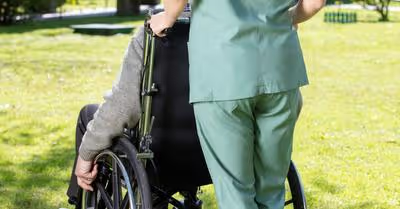Table of Contents
What is Assisted Living?
Assisted living facilities provide comfortable and safe living environments for seniors. Many of the people in these facilities are in reasonably good health, both physically and mentally, but they simply prefer the convenience and security provided by the facility.
What does assisted living provide?
An assisted living facility will provide personalized care for each resident. They’re able to do this in large part because the residents don’t need 24/7 care. This includes things like medication management, housekeeping, and meal service.
If the residents need it, it will also include assistance with things like using the restroom, grooming, and dressing. Many residents in assisted living facilities can handle these tasks on their own, though.
Transportation services, activities, and social engagements with other residents are also provided in these facilities. Typically, residents are encouraged to bring their own furniture and household items with them to ensure that they feel at home.
Some of these facilities look and feel more like apartments and townhomes than anything else, and, in fact, the only real difference is the larger staff and higher level of care they provide for their residents. You might be surprised by the number of these facilities you pass by every day, since many of them simply look like upscale apartment complexes.
In some places they provide duplexes rather than apartments, and in these facilities the residents have a high degree of independence. While they still receive assistance with medication management, and have a dining hall to eat in, they also have the option of preparing their own meals.
What doesn’t assisted living provide?
The main thing to know here is that an assisted living facility will not provide full time care or skilled medical care to its residents. Some facilities will include a memory care unit, but many do not.
That means that, depending on the physical and mental condition your loved one is in, an assisted living facility may not be suitable for your needs. Assisted living facilities are really intended for seniors who are still largely able to care for themselves, and only need assistance with some basic daily tasks.
Activities of Daily Living
Activities of Daily Living (ADLs) are the primary reason why individuals choose to move to an assisted living facility. Residents in AL facilities typically need help with at least two common daily tasks, and the most common ones are:
- Walking
- Bathing
- Eating
- Bed transfer
- Using the toilet
- Dressing
Who is Assisted Living For?
Assisted living dramatically improves the quality of life for seniors who need help with ADLs. Assisted Living is suitable for most seniors, and will probably benefit almost any senior citizen.
Remember that this isn’t full-time care or skilled nursing care, so someone who needs that level of care shouldn’t be looking at assisted living.
Many residents of assisted living facilities don’t actually need all that much care, and they simply enjoy the benefits of having their meals and housekeeping provided so that they don’t have to do those chores themselves. They also enjoy the benefits of living in a community of seniors. There are social activities organized for everyone, and they get to maintain a high level of independence.
In fact, it’s the independence that really draws many of the residents in. They can maintain a lot of their independence in an assisted living facility, without sacrificing their safety or their health.
So, assisted living is for any senior who wants to maintain their independence and quality of life for as long as possible.
How Do I know if I or Someone I Love Needs Assisted Living?
While it can be difficult to decide to move into an assisted living facility, there are some clear signs that will help you to decide. And, remember, this move will almost certainly improve the quality of life for the resident.
Here are some of the most clear signs that someone would benefit from an assisted living facility:
- At least one fall in the last year, whether it resulted in injury or not
- Difficulty walking around the house
- It’s becoming difficult to prepare meals
- You notice signs that their nutritional needs aren’t being met, or they’re hungry all the time
- They need assistance with activities of daily living
- You find yourself worrying about their safety, or you think they seem isolated and lonely
If you or a loved one has shown any of these signs, assisted living is something you should strongly consider. Loneliness and isolation can have profound negative effects on our health, and that only becomes more true as we grow older.
Even if there’s little to no need for ADL assistance, the community provided by an assisted living facility can be invaluable, and that alone may improve quality of life. However, once you or a loved one develops a need for ADL assistance, there’s really no question that you need assisted living at that point.
What’s the Difference Between Assisted Living and a Nursing Home?
The terms nursing home and assisted living facility are often used interchangeably, but that’s very misleading. In fact, nursing home is a term that’s being used less and less these days, as more accurate terminology is now available.
Most of what people refer to as nursing homes are more properly described as skilled nursing facilities, and these provide a very high level of care. Generally, these facilities are capable of providing full-time care, and can provide more skilled nursing and medical care.
Residents of skilled nursing facilities need a lot more than just help with ADLs; they typically need the attention of nurses, and their physical or mental health needs prevent them from maintaining the level of independence offered by an Assisted Living facility.
In contrast, residents of an Assisted Living Facility are nearly as independent as they were at home. Their meals are provided for them, and their housekeeping and other chores are done for them, but they spend most of their time unsupervised.
The differences between these two types of facility become clear when you see them. The living spaces in an Assisted Living Facility are very clearly homes. Often, they’re multi-bedroom apartments and townhomes, and families who want to visit the residents can stay with them there. They have kitchens, living rooms, sometimes even garages and small yards.
Skilled nursing facilities look and feel like long-term medical care spaces. The rooms are often just that- a room, with a bed, maybe a chair or a chair, a TV, and a separate bathroom. There are typically no guest spaces, so visitors can’t stay on site. You won’t really find private living rooms or kitchens, and there’s often medical equipment in each room.
Recent Articles
















